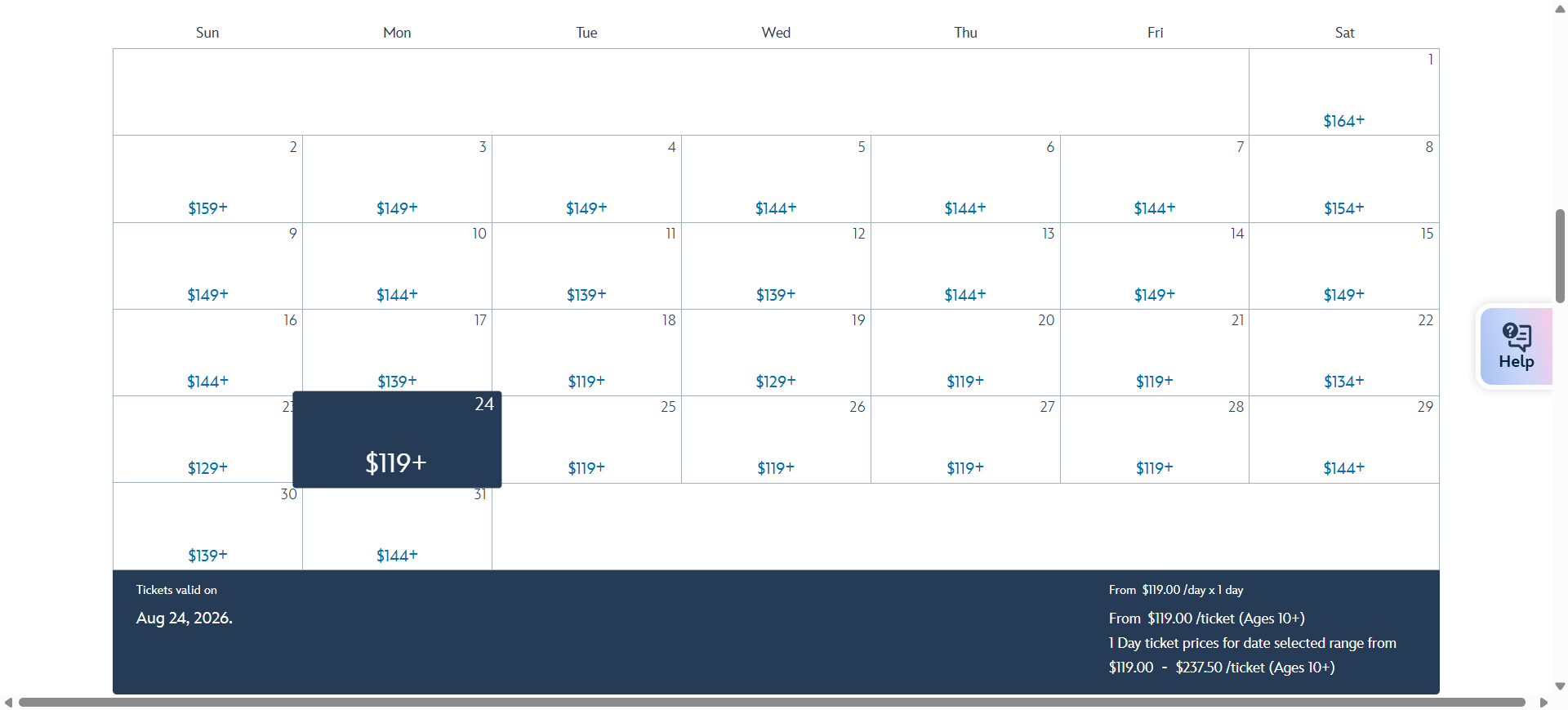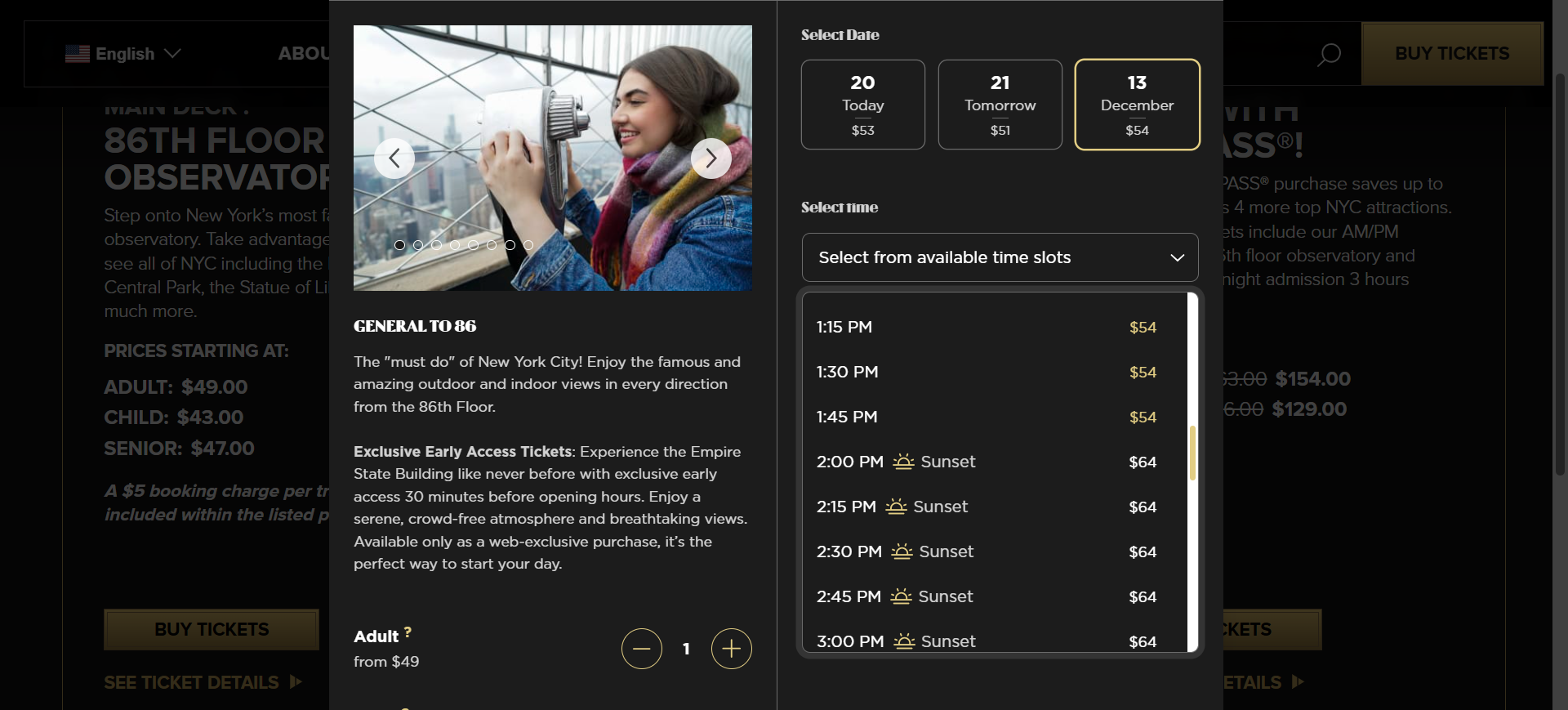If you’ve ever booked an airline ticket or a hotel room online, you’ve probably become accustomed to airline and hotel prices changing based on both when you buy your tickets and when you want to travel.
Or, if you’ve tried to get an Uber after a concert, you may have found that your ride home, when a “surge” of people was also looking for a ride, may have cost twice as much as your ride there.
This system, called dynamic pricing, is designed to help companies squeeze out every drop of revenue they can by charging more when demand is at its highest. (Even Las Vegas lobby shops are getting in on the act!)
With new tech in the mix, attractions ranging from the Empire State Building to small-town museums are now using dynamic pricing. As a result, prices can shift depending on when you book, how many people are booking and even the time of day you want to visit. It’s confusing, frustrating and usually means paying more than you expected.
But it doesn’t have to be that way. Knowing how these price changes work and using a few simple tricks can keep more money in your wallet. Here’s what you need to know to outsmart dynamic pricing while still getting the experiences you’re after.
What is dynamic pricing?
Dynamic pricing means ticket prices aren’t fixed — they shift depending on demand. When lots of people want in, prices climb. When it’s slow, prices dip. Simple enough, but it can mess with your trip if you’re not paying attention.
This system can be simple, like dividing the calendar into peak and off-peak seasons. But, with artificial intelligence-powered strategies, price shifts are possible based on real-time visitor numbers, the weather or even Google Analytics search volume.
The key word to understanding dynamic pricing is “when” — both when you purchase and when you want to go. Wait too long or pick a busy day, and your wallet takes a hit. But if you know how this game works, you can play it to your advantage.
Let me give you an example with an upcoming trip I’m taking to Universal Studios Hollywood. By visiting on a Thursday instead of over the weekend, the one-day ticket price dropped from $139 to $109. I’ll happily turn that savings into Butterbeer!

Daily Newsletter
Reward your inbox with the TPG Daily newsletter
Join over 700,000 readers for breaking news, in-depth guides and exclusive deals from TPG’s experts
By signing up, you will receive newsletters and promotional content and agree to our Terms of Use and acknowledge the data practices in our Privacy Policy. You may unsubscribe at any time.
It all started with a mouse: How Disney pioneered dynamic pricing for attractions
In 2016, Disney introduced seasonal pricing, which was a new concept for attractions.
This new system divided the calendar into Value, Regular and Peak periods with different prices for each, reflecting expected crowd levels. For example, a one-day Magic Kingdom ticket during a Value period was $105, but on Peak days it jumped to $124.
This strategy was designed to better manage attendance and spread visitors more evenly throughout the year, while aligning prices with demand. Once Disney started the trend, Universal and other theme parks nationwide started seasonal pricing within a few years.

Fast forward to today, and theme park pricing is more sophisticated, with prices varying by day instead of by season. Disney has an advantage because it knows so much about its customers’ behavior from both the My Disney Experience app and the treasure trove of data from Disney+ and Hulu. Disney World even offered discounts specific to Disney+ members last summer.
Consider Disney World ticket prices for August 2026 to get an idea of how dynamic pricing works. Prices vary between $119 and $164 for a one-day Magic Kingdom ticket, depending on which day in August you visit. There’s a difference of $45 per day, or 27%, between the two, which, when you consider multiple tickets, will add up quickly. The difference can be chalked up to back-to-school season, so unless your kids go back in early August, you might want to hold off until the end of the month.
The ride doesn’t stop: Why dynamic pricing is hitting all your favorite spots
Even a decade ago, smaller attractions didn’t have the tech muscle needed to handle daily dynamic pricing. Big parks like Disney built their own systems with whole teams figuring out when to raise or drop prices. But now, ready-made software systems make dynamic pricing doable for zoos, museums and smaller spots.
When off-the-shelf tools do the heavy lifting — analyzing visitor trends, weather and demand — there’s no need for a data science department. This tech shift has opened the door for more attractions to jump on dynamic pricing, letting them tweak prices without having to add more staff. It’s why you’ll now see variable pricing well beyond the theme park giants, even at your local aquarium or history museum.

The Empire State Building has become a poster child for AI-driven dynamic pricing, using machine learning algorithms to adjust ticket prices in real time based on factors like demand, weather, time of day and even local events. This means that the price you see online today could go up tomorrow.
This approach allows management to optimize both revenue and crowd management, helping to smooth out busy days and fill quieter times. Take a look at the price chart above for Dec. 13. The price goes up $10 per person if you visit at 2 p.m. instead of 1:45 p.m. Better make that lunch reservation early.
Dynamic pricing crosses the pond
Dynamic pricing is no longer red, white and blue; it’s making waves in Europe’s museums and cultural attractions, too. It’s a handy tool for destinations battling overtourism, which TPG outlined as a major issue in its 2025 Travel Trends report.
For example, the Deutschlandmuseum in Berlin has a chart with prices that can double depending on the day and time you choose.

Even entire cities are getting in on the trend. Venice, Italy, now charges day-trippers up to 10 euros per person to visit the city in peak season. Destinations are using peak-season and dynamic pricing to encourage “de-seasonalization”, i.e., spreading out tourism so attractions and city streets are less likely to be overwhelmed.
How to beat dynamic pricing
Now that you’re aware of how dynamic pricing works, here’s how you can avoid paying a premium when you visit attractions.
Go when others don’t
Knowledge is half the battle. If you have any flexibility in your travel dates, take a look at attraction prices at the same time you shop for a hotel and airfare. Most websites publish monthly calendars so you can see what to expect, and you can plan to avoid the highest prices.
Also make sure you’re taking a look at daily (or even hourly) entry rates before buying your tickets. Even a 15-minute time difference when visiting the Empire State Building could save a family of four $40.
Look for combos and passes
While the site you want to visit may have dynamic pricing, it’s likely that a tourist pass that includes multiple destinations is the same price no matter when you visit.
For instance, if you want to visit New York during a peak time, consider the New York CityPass, which is the same price no matter which days of the year or times of day you use it. It allows you to visit five among a list of eight top attractions spread out over 10 days. If you want to visit a number of attractions with variable pricing, including, yes, the Empire State Building, the savings could add up quickly.
This especially matters for a peak season such as spring break. You could save more than $100 for a spring break trip to the Big Apple by buying the $156 CityPass instead of being subject to dynamic pricing whims.
| Empire State Building | $77.30 |
|---|---|
| American Museum of Natural History | $36.00 |
| Circle Line Landmarks Cruise | $45.00 |
| Top of the Rock | $66.00 |
| 9/11 Memorial | $36.00 |
| Total | $260.30 |
Stack deals to save
You might think that buying tickets directly from the source is the way to get the best prices, but that’s not necessarily true. Attraction brokers such as Viator often sell tickets and tourist passes at the same price you’ll pay when buying directly, but you can stack coupons and shopping portals to both maximize points and save money.
For instance, Viator offers Empire State Building tickets for the same price as buying directly. American Airlines eShopping recently offered not only 4.5 miles per dollar spent when booking on Viator through its portal, it also displayed a coupon for 12% off $300. That’s an extra 1,350 AAdvantage miles and $36 back in your wallet in addition to the miles or points you would normally earn on your $300 purchase.
But we’re not done yet. Be sure to check your credit card offers before hitting that purchase button. You might find a targeted offer such as the one American Express recently offered, which could add another $30 cash back to your $300 purchase. And as a bonus, Viator tickets have a free cancellation policy, which tickets bought from the Empire State Building website don’t offer.
Bottom line
Dynamic pricing is here to stay, but it’s not all bad news. Once you understand how the system works, you can sidestep the highest prices. And by using passes and stacking offers, you can outsmart the bots working to bust your vacation budget.
Best of all, you can use the knowledge the system gives you to schedule your visits for those less-expensive days and time slots. Not only will you save money, visiting when others don’t has the added benefit of smaller crowds, too.
Related reading:
Disclaimer : This story is auto aggregated by a computer programme and has not been created or edited by DOWNTHENEWS. Publisher: thepointsguy.com






